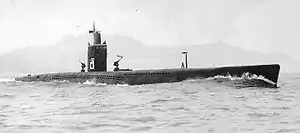I-201-class submarine
The I-201-class submarines (伊二百一型潜水艦, I-ni-hyaku-ichi-gata sensuikan) were submarines of the Imperial Japanese Navy during World War II. These submarines were of advanced design, built for high underwater speed, and were known as Sentaka-Dai type submarine (潜高大型潜水艦, Sen-Taka-Dai-gata sensuikan, "Submarine High speed-Large type") or Sentaka type submarine (潜高型潜水艦, Sen-Taka-gata sensuikan, "Submarine High speed type"). The type name, was shortened to Suichū Kōsoku Sensuikan Ō-gata (水中高速潜水艦大型, Underwater High speed Submarine Large type).[1]
 Sentaka I-202 at high surface speed | |
| Class overview | |
|---|---|
| Builders | Kure Naval Arsenal |
| Operators | |
| Preceded by | I-400-class submarine |
| Subclasses |
|
| Built | 1945 |
| In service | 1945 |
| In commission | 1945 |
| Planned | 23 |
| Completed | 3 |
| Scrapped | 3 |
| General characteristics | |
| Type | Submarine |
| Displacement |
|
| Length |
|
| Beam |
|
| Height | 7 m (23 ft) (keel to main deck) |
| Propulsion |
|
| Speed |
|
| Range | |
| Test depth | 110 m (360 ft) |
| Complement |
|
| Armament |
|
They were one of the fastest submarine class built during World War II, second only to Walter Type XVII closed-cycle powered submarines. Twenty-three units were ordered from the Kure Naval Arsenal under the 1943 construction program. Due to the deteriorating war situation, only eight boats were laid down, and only three, numbered I-201, I-202 and I-203, were completed before the end of the war. None of them saw operational use.
Background
In 1938 the Imperial Japanese Navy constructed an experimental high-speed submarine for evaluation purposes, which was designated Vessel Number 71 (第71号艦) for security purposes. Based on previous experience with high-speed, short-range midget submarines, Number 71 displaced only 230 tons surfaced with a length of 140 ft (43 m). She could attain a submerged speed of over 21 kn (39 km/h; 24 mph), making her the fastest submarine of her day. The results gained from experiments with Number 71 formed the basis for the I-201 class submarines.[2]
Design

By late 1942 it had become apparent to the IJN that conventional submarines were unable to survive the new ASW techniques coming into service, such as radar, HF/DF, sonar, and new depth charge projectors. New submarines were required, with a higher underwater than surface speed, quick-diving capability, quiet underwater running, and a high underwater operational radius.
The IJN General Staff made an official request for high-speed submarines in October 1943 and among the ships planned in 1944 to be constructed in 1945 were 23 "underwater high speed submarines" (Sen taka) temporarily designated "Ships No. 4501–4523".
The General Staff's final requirements were stated in Order No. 295 dated 29 October 1943 to the Navy Technical Department. These included an underwater speed of 25 kn (46 km/h; 29 mph) which was reduced to 20 kn (37 km/h; 23 mph) for practical reasons. Nevertheless, they were the fastest operational submarines of World War II, outpacing even the German Type XXI.[3]
To meet the requirement for high underwater speed the designers had to:
- Adopt a single-hull structure
- Locate the main ballast tank higher than previous submarines to give a higher center of gravity and improve dynamic stability
- Give the pressure hull and casing a highly streamlined form
- Make the conning tower as small as possible
- Replace fixed deck guns with retractable mounts housed in shuttered recesses when submerged.
- Use steel plates for the upper deck rather than wood
- Install underwater charging system (snorkel)
- Fit large horizontal control surfaces at the stern instead of the more usual bow-mounted dive planes; this improved directional stability and may have decreased turbulence-induced drag.[4]
- Reduce the crew and crew accommodation to provide battery space; the Sen-Taka was designed for a crew of 31, compared to that the similar-sized Sen-Chu (54), and the Kai Dai 1 (60) Types (in practice the SenTaka needed a crew of 50 when it became operational, leading to an unforeseen habitation problem).
- Restrict the armament, also to save space; the Sen-Taka had the same torpedo outfit as the smaller Sen-Chu 2nd class submarine, and just half that of the comparable Kaidai 1st class submarine. Also the Sen-Taka had no deck gun, and the AA armament carried had to be held in retractable mounts, requiring hull space, in order to meet the streamlining requirement.
The I-201 class bore little resemblance to earlier I-boats, which were optimized for long range and high surfaced speed. By contrast, the I-201 emphasized submerged performance. It featured powerful electric motors, streamlined all-welded hulls, and a large capacity battery consisting of 4,192 cells. The maximum underwater speed of 19 knots (35 km/h) was double that of contemporary American designs. The I-201s, like other Japanese submarines of the period,[5] were also equipped with a crude snorkel, allowing underwater diesel operation while recharging batteries.
I-201 displaced 1,291 tons surfaced and 1,451 tons submerged. It had a test depth of 360 feet (110 m). Armament consisted of four 53 cm (21 in) torpedo tubes and 10 Type 95 torpedoes. The two 25 mm anti-aircraft guns were housed in retractable mounts to maintain streamlining. The submarine was designed for mass production, with large sections prefabricated in factories and transported to the slip for final assembly.
Fate
Two submarines, I-201 and I-203, were seized and inspected by the US Navy at the end of the hostilities. They were part of a group of four captured submarines, including the giant I-400 and I-401, which were sailed to Hawaii by US Navy technicians for further inspection.
On 26 March 1946, the US Navy decided to scuttle these captured Japanese submarines to prevent the technology from falling into the hands of the Soviet Union. On 5 April 1946, I-202 was scuttled in Japanese waters. On 21 May 1946, I-203 was torpedoed and sunk by submarine USS Caiman off the Hawaiian Islands. On 23 May 1946, I-201 was torpedoed and sunk by USS Queenfish. The Hawaii Undersea Research Laboratory found the wreck of the I-201 near Hawaii using submersible craft in 2009.[6]
Boats in class
| Sub class | Boat # | Boat | Builder | Laid down | Launched | Completed | Decommissioned | Fate |
| I-201 (Pr. S563) | 4501 | I-201[7] | Kure Naval Arsenal | 1 March 1944 | 22 July 1944 | 2 February 1945 | 30 November 1945 | Sunk as a target off the Hawaiian Islands by USS Queenfish on 23 May 1946 |
| 4502 | I-202 | 1 May 1944 | 2 September 1944 | 12 February 1945 | 30 November 1945 | Scuttled by U.S. Navy off Gotō Islands on 5 April 1946 | ||
| 4503 | I-203 | 1 June 1944 | 20 September 1944 | 29 May 1945 | 30 November 1945 | Sunk as a target off the Hawaiian Islands by USS Caiman on 21 May 1946 | ||
| 4504 | I-204 | 1 August 1944 | 16 December 1944 | 90% complete, sunk by air raid on 22 June 1945, salvaged and scrapped at Kure February–May 1948 | ||||
| 4505 | I-205 | 4 September 1944 | 15 February 1945 | 80% complete, sunk by air raid on 28 July 1945, salvaged and scrapped at Kure May–August 1948 | ||||
| 4506 | I-206 | 27 October 1944 | 26 March 1945 | 85% complete, construction stopped on 26 March 1945, scrapped at Kure October 1946-January 1947 | ||||
| I-207 (Pr. S56B) | 4507 | I-207 | 27 December 1944 | 20% complete, construction stopped on 17 April 1945, scrapped at Kure April–May 1946 | ||||
| 4508 | I-208 | 17 February 1945 | 5% complete, construction stopped on 17 April 1945, scrapped at Kure April–May 1946 with I-207[8] | |||||
| 4509-4523 | Constructions were not started until the end of the war. |
Influences
The I-201 design and technology influenced Japanese Maritime Self Defense Force JDS Oyashio (1959).
In fiction
A refurbished I-203 is used by the characters in the film Hell and High Water (1954).
Notes
- The 潜高大 read as "Sentaka-Dai", but the 高速 read as "Kō-soku" and 大型 read as "Ō-gata" in Japanese.
- Stille, p. 38
- Stille, Mark. Imperial Japanese Navy Submarines 1941-45 (Osprey, 2007), p.38.
- Lengerer, p. 62
- Stille, p.35 & passim.
- Henry Fountain (November 14, 2009). "2 Sunken Japanese Subs Are Found Off Hawaii". New York Times. Retrieved November 14, 2009.
- 伊号第201潜水艦 (I-Gō Dai-201 Sensuikan). The same shall apply hereinafter.
- Lengerer, p. 75
References
- Lengerer, Hans (2006). "The High-Speed Submarines of the I 201 Class". Warship. Chrysalis Books. 28: 59–77.
- Stille, Mark; Tony Bryan (2007). Imperial Japanese Navy Submarines 1941-45. Osprey Publishing. ISBN 978-1-84603-090-1.
- Stille, Mark. Imperial Japanese Navy Submarines 1941-45. Osprey, 2007.
- "Rekishi Gunzō"., History of Pacific War Vol.17 I-Gō Submarines, Gakken (Japanese publishing company), January 1998, ISBN 4-05-601767-0
- The Maru Special, Japanese Naval Vessels No.132, Japanese submarines I, Ushio Shobō (Japanese publishing company), February 1988
